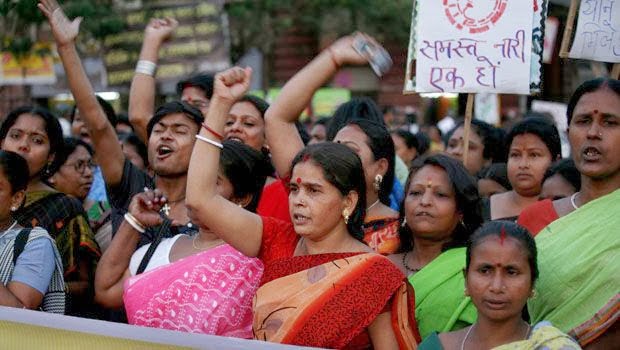“Sometimes all the talk of equality sounds like the hollow beating of distant drums,” writes Richa Nagar in her book Playing with fire: Feminist thought and activism through seven lives in India. This sentiment encapsulates the state and role of Non-Governmental Organizations (NGOs) today and how their micro-politics, often operating within a capitalist nexus, has co-opted the larger struggles of the Indian Women’s Movement.
NGOs, as described by the World Bank are, “Private organisations that pursue activities to relieve suffering, promote the interests of the poor, protect the environment, provide basic social services, or undertake community development.” They have had multifold functions in Indian society. They have acted as pressure groups to demand accountability from the state, worked extensively to organize social movements and have also acted as service providers at the grassroots level.
Their structures and roles have evolved significantly and resulted in various phenomena that cannot be seen in isolation from the feminist movement in India. One such phenomenon is called NGOisation which is the, “Institutionalization, professionalization, depoliticization and demobilization of movements for social and environmental change.”
Pre-Colonial and Colonial Period
Before colonialism, these NGOs existed as socio-economic structures which were self-serving. They were touted as safety or security nets used by the people for their own selves. These have been described as ‘societal’ rather than ‘etatist’ organisations. After the coming of colonialists, they brought with them Christian Missionaries or Churches – which have been seen by many as invasive forces imposing reforms especially on the impoverished communities. Their primary objective was to ensure the spread of health and education and provide other social services. Their role has always been contested and is seen as bordering on the white saviour complex, which assumes non-white people as savages.
It was only after the Emergency, that India saw a parallel rise in the second phase of the women’s movement as well as women’s organization. These worked in tandem on issues of dissent, environment, censorship, human rights, gender and reproductive rights in the aftermath of the excesses committed during the Emergency period. NGOs in this period were dissenting forces which held the state accountable as well as organisations committed to social reform.
The independence struggle or the anti-colonial movement also led to the emergence of many Indian organisations that were touted as reformist groups especially in the social and religious arena. They took up issues of women and children. Reformers like Raja Ram Mohan Roy advocated strongly against sati, child marriage and also fought for the rights of widows to be able to remarry. Some of these organizations also invested in women’s education and questioning the purdah system.
However, as Dr. BR Ambedkar said, these social reforms for women did not focus on breaking up the caste hierarchies. Often these social organizations operated in a way to accommodate Hindu women within Brahminical, patriarchal structures instead of reforming Hinduism as a religion – which aggressively perpetuated untouchability and graded inequality, in the name of the caste system. These organisations were thus seen as an interlink between social reform and anti-colonialism because of their underlying political and activist character. The 1860 Registration of Societies Act was also passed to keep a track of them, since they operated outside the colonial state.
Post Independence and the Emergency Period
Post independence, there was a steady surge of self reliant organisations, based on Gandhi’s model which were concerned with Khadi, agriculture, healthcare, spinning etc. They faced a decline in the 1960s. It was only after the Emergency, that India saw a parallel rise in the second phase of the women’s movement as well as women’s organization.
These worked in tandem on issues of dissent, environment, censorship, human rights, gender and reproductive rights in the aftermath of the excesses committed during the Emergency period. NGOs in this period were dissenting forces which held the state accountable as well as organisations committed to social reform.
Globalization: On Neo Liberalisation and Funding
The 1990s saw the Indian Government pushing for policies of economic liberalization, privatization and globalization. Structural Adjustment Programs or SAPs were being introduced that brought with them the ‘international donor-driven NGO boom.’ Institutions like the World Bank and IMF compelled the state to withdraw from the public sectors which were essential. This gap was created so that the ‘development sector’ could emerge and thrive. Thus the poor and the marginalized, instead of depending on the government, were left at the mercy of the NGOs which brought along with it, its own set of problems.
Most women’s organizations and NGOs are run by elite feminists who have a top-down approach. Instead of local women leaders, we will usually see policy ‘buffs’ or experts working here. Since these same organizations also participate in the larger women’s movement, their decisions often drown out the voices of grassroots collectives who don’t have a say in decision-making.
Within NGOs, there will always be a gap between feminist theory and praxis. The Foreign Contributions Regulations Act (FCRA, 1976) leaves a major chunk of the development sector to get approval for international funding from the state. As a result of competition to acquire funding, these NGOs are forced to establish a corporate and professional culture, complete with organizational hierarchies.
Naturally, upper-middle class intellectuals or women who have had the social capital to get a good education are preferred as employees over marginalized women from the community. Most women’s organizations and NGOs are run by elite feminists who have a top-down approach. Instead of local women leaders, we will usually see policy ‘buffs’ or experts working here. Since these same organizations also participate in the larger women’s movement, their decisions often drown out the voices of grassroots collectives who don’t have a say in decision-making. Representation in these organizations, then becomes a huge problem – either there is none, or even if there is, it is accompanied with tokenism.
Also read: Six Women’s Movements From The North East That You Should Know Of
In February 2019, several accounts of bullying and harassment faced by Amnesty International employees in India emerged. The organization was accused of promoting a toxic work culture that also propagated caste discrimination and Islamophobia. This lead to widespread condemnation of Amnesty International and many Dalit activists like Radhika Vemula and Chandrashekhar Azad withdrew their support from it. Similarly NGOs like The Ford Foundation, Oxfam, Greenpeace have been accused of collaborating with capitalist corporations which otherwise trample on the rights and land of tribal people and migrant workers.
Conclusion
Thus, the relationship between NGOs and the Women’s Movement has lead to a loss of collective feminist politics which was based on autonomy like in the 1980’s. The nexus of state, CSR, corporates and NGOs has depoliticized the women’s movement. This has become quite a dangerous phenomenon in the present context, especially considering how the rise of Hindutva is promoting a homogeneous identity and culture.
This phenomenon of NGOization can also be witnessed within Women’s Development Cells of colleges which have become apolitical in the recent past. This is an extremely dangerous trend as it produces a generation of ‘career feminists’ who instead of organically engaging in the women’s movement, head towards adopting a very white-washed (or pink-washed) ‘brand’ of feminism.
NGOization of the women’s movement has led to prominent issues which the state may have a problem with, being pushed to the back burner. Sexual violence, mental health, LGBTQIA+ rights maybe addressed by the feminist movement today but they do very little to fight against systematic and institutional causes that result in these inequities and violence.
For example, while an NGO might spread awareness about sexual and reproductive health rights for unmarried women, at the same time it may charge a hefty fees to help women get safe abortions. So instead of being a watchdog and urging the public healthcare infrastructure to provide nominal sexual and reproductive healthcare services to women from all communities, it itself becomes a privatized service delivery agency where only women with some capital can access abortions.
Also read: Hindutva Mobilisation Of Women —A Serious Concern For Women’s Movement
This phenomenon of NGOization can also be witnessed within Women’s Development Cells of colleges which have become apolitical in the recent past. They do not adequately address structural problems of caste and Islamophobia especially faced by women within universities, but will organize pride face painting competitions in collaboration with NGOs. This is an extremely dangerous trend as it produces a generation of ‘career feminists’ who instead of organically engaging in the women’s movement, head towards adopting a very white-washed (or pink-washed) ‘brand’ of feminism.
Featured Image Source: The Indian Culture ID
About the author(s)
Imperfect Feminist and Literature Student. Raging to build a kinder world.





Amazing piece of work, learnt so much.
This has been one of my favorite articles of all time!